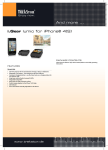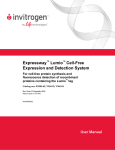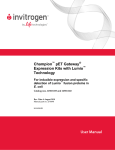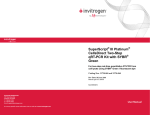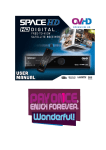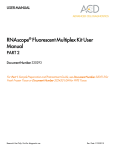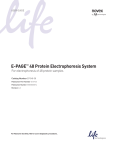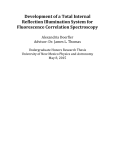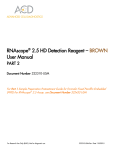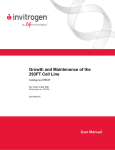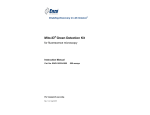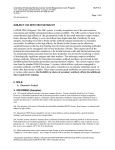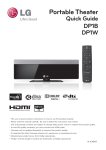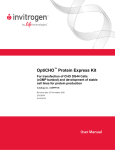Download Labeling Lumio™ Fusion Proteins, continued
Transcript
Lumio™ In-Cell Labeling Kits For site-specific fluorescent labeling and detection of Lumio™-tagged proteins in live mammalian cells Catalog nos. 12589-040 and 12589-057 Version C 27 June 2005 25-0700 Corporate Headquarters Invitrogen Corporation 1600 Faraday Avenue Carlsbad, CA 92008 T: 1 760 603 7200 F: 1 760 602 6500 E: [email protected] For country-specific contact information visit our web site at www.invitrogen.com User Manual ii Table of Contents Kit Contents and Storage ..................................................................................................................................... v Accessory Products............................................................................................................................................. vii Product Qualification ........................................................................................................................................viii Introduction ................................................................................................................... 1 Overview.................................................................................................................................................................1 Lumio™ Technology ..............................................................................................................................................2 Working with Arsenic Compounds ....................................................................................................................5 Methods ......................................................................................................................... 6 General Guidelines for Lumio™ Labeling...........................................................................................................6 General Guidelines for Dual Lumio™ Labeling .................................................................................................9 General Guidelines for Detecting Lumio™ Fusion Proteins...........................................................................10 Labeling Lumio™ Fusion Proteins .....................................................................................................................11 Using Disperse Blue 3 .........................................................................................................................................16 Detecting Lumio™ Fusion Proteins....................................................................................................................18 Appendix...................................................................................................................... 21 Troubleshooting ...................................................................................................................................................21 Technical Service..................................................................................................................................................23 Purchaser Notification ........................................................................................................................................24 References .............................................................................................................................................................25 iii iv Kit Contents and Storage Types of Kits This manual is supplied with the products listed below: Product Catalog no. ™ 12589-040 ™ 12589-057 Lumio Red In-Cell Labeling Kit Lumio Green In-Cell Labeling Kit Additional Kits The following products include one or both of the kits listed above: Product Catalog no. ™ Shipping/Storage ® ™ Mammalian Lumio Gateway Vectors with Lumio Green In-Cell Labeling Kit 12589-016 Mammalian Lumio™ Gateway® Vectors with Lumio™ Red In-Cell Labeling Kit 12589-024 Mammalian Lumio™ Gateway® Vectors with Lumio™ Dual Green and Red In-Cell Labeling Kit 12589-032 ViraPower™ II Lentiviral C-Lumio™ Gateway® Expression System K370-20 ViraPower™ II Lentiviral N-Lumio™ Gateway® Expression System K371-20 The Lumio™ In-Cell Labeling Kits are shipped on blue ice. Upon receipt, store as detailed below. Kit ™ Storage ™ Lumio Red In-Cell Labeling Kit Lumio Red: -20ºC, protected from light Disperse Blue 3: -20ºC Lumio™ Green In-Cell Labeling Kit Lumio™ Green: -20ºC, protected from light Disperse Blue 3: -20ºC The following reagents are supplied with the Lumio™ In-Cell Labeling Kits. Store Lumio™ In-Cell the Lumio™ Green or Lumio™ Red Labeling Reagent at -20ºC, protected from Labeling Reagents light. Store Disperse Blue 3 at -20ºC. All components are stable for at least 6 months under these conditions. Reagent Composition Amount In-Cell Labeling Reagent (Lumio™ Green or Lumio™ Red) 2 mM in DMSO 40 µl Disperse Blue 3 20 mM in DMSO 200 µl continued on next page v Kit Contents and Storage, continued Molecular Weights The table below lists the molecular weights and micrograms supplied for each Lumio™ Labeling Reagent. of the Labeling Reagents Reagent µg Supplied 664.50 g/mol 53.2 ™ 545.38 g/mol 43.6 Lumio Green Labeling Reagent Lumio Red Labeling Reagent vi Molecular Weight ™ Accessory Products Accessory Products Additional products that may be used with the Lumio™ In-Cell Labeling Kits are available from Invitrogen. For more information about these products, refer to our Web site (www.invitrogen.com) or contact Technical Service (page 23). Item Amount Catalog no. Opti-MEM® I Reduced Serum Medium (1X), Liquid 100 ml 31985-062 500 ml 31985-070 Hank’s Balanced Salt Solution (HBSS) (with calcium and magnesium, but no phenol red) 500 ml 14025-092 1L 14025-076 HEPES Buffer Solution (1 M) 20 ml 15630-106 100 ml 15630-080 vii Product Qualification Introduction The components of the Lumio™ In-Cell Labeling Kits are qualified as described below. Lumio™ Labeling Reagents The Lumio™ Green and Lumio™ Red Labeling Reagents are qualified as follows: Purity: Determined by HPLC Mass: Determined by mass spectroscopy Functionality: To ensure performance, the Lumio™ Labeling Reagents are functionally tested using GripTite™ 293 MSR cells transfected with the pcDNA™6.2/nLumio™-GW/p64 vector and using the protocols included in this manual. Disperse Blue 3 viii The concentration of Disperse Blue 3 is qualified by spectrophotometry. To ensure performance, Disperse Blue 3 is also functionally tested using GripTite™ 293 MSR cells transfected with the pcDNA™6.2/nLumio™-GW/p64 vector and using the protocols included in this manual. Introduction Overview Introduction The Lumio™ In-Cell Labeling Kits use the Lumio™ Technology to facilitate sitespecific fluorescent labeling of proteins in live mammalian cells. Use of the Lumio™ Technology provides a sensitive method for in vivo detection and subcellular localization of proteins fused to the Lumio™ tag using fluorescence microscopy. Advantages of the Lumio™ Labeling System Using the Lumio™ Technology and the Lumio™ In-Cell Labeling Kits for fluorescent labeling of recombinant proteins provides the following advantages: Purpose of this Manual • Small size of the Lumio™ tag (6 amino acids, 585 Da) is less likely to interfere with the structure or biological activity of the protein of interest • Lumio™ Labeling Reagents are membrane-permeable and readily cross the cell membrane, allowing labeling and detection of recombinant proteins in live mammalian cells • Lumio™ Labeling Reagents bind the Lumio™ tag with high specificity and high affinity (nanomolar or lower dissociation constant), allowing targeted labeling of the protein of interest • Lumio™ Labeling Reagents become strongly fluorescent only upon binding the Lumio™ tag, allowing specific detection of Lumio™-tagged proteins This manual provides the following information: • An overview of the Lumio™ Technology, including the Lumio™ Green and Lumio™ Red Labeling Reagents. • Guidelines and instructions for using the Lumio™ Labeling Reagents to label your protein of interest. • Guidelines and instructions to detect your Lumio™-labeled protein in live mammalian cells using fluorescence microscopy. 1 Lumio™ Technology Introduction Lumio™ In-Cell Labeling Kits are based on FlAsH (Fluorescein Arsenical Hairpin) technology, which uses biarsenical labeling reagents to bind and detect proteins containing a tetracysteine motif (Griffin et al., 1998). The biarsenical labeling reagents are nonfluorescent until they bind the tetracysteine motif at which time they become highly fluorescent. Components of the Lumio™ System The Lumio™ System consists of two major components: • The tetracysteine Lumio™ tag (Cys-Cys-Pro-Gly-Cys-Cys). When fused to a gene of interest (in the context of a Lumio™ vector), the Lumio™ tag allows the expressed fusion protein to be specifically recognized by a biarsenical labeling reagent. For more information on the tetracysteine motif, see below. • A biarsenical labeling reagent, Lumio™ Green or Lumio™ Red, which becomes fluorescent upon binding to recombinant proteins containing the Lumio™ tag. The Lumio™ Green and Lumio™ Red Labeling Reagents are supplied precomplexed to the dithiol EDT (1,2-ethanedithiol) which stabilizes and solubilizes the biarsenic reagents. For information on how the Lumio™ Reagent binds the Lumio™ tag and becomes fluorescent, see the next page. Tetracysteine Motif The Lumio™ Reagents bind a tetracysteine motif consisting of Cys-Cys-Xaa-XaaCys-Cys where Cys equals cysteine and Xaa equals any amino acid other than cysteine. This motif is rarely seen in naturally occurring proteins allowing specific fluorescent labeling of recombinant proteins fused to the Lumio™ tag. In the Lumio™ System, the optimized Cys-Cys-Pro-Gly-Cys-Cys tetracysteine motif is used as this motif has been shown to have a higher affinity for and more rapid binding to biarsenic compounds as well as enhanced stability compared to other characterized motifs (Adams et al., 2002). Lumio™ Green Labeling Reagent The Lumio™ Green Labeling Reagent is based on the FlAsH reagent and is a nonfluorescent, biarsenical derivative of fluorescein (Griffin et al., 1998). Lumio™ Green is supplied pre-complexed to EDT, is membrane-permeable, and readily enters the cell. See the figure below for the structure of the Lumio™ Green Reagent. S HO As S S As S O O Formula: C24H18As2O5S4 Molecular Weight: 664.50 COOH continued on next page 2 Lumio™ Technology, continued Lumio™ Red Labeling Reagent The Lumio™ Red Labeling Reagent is based on the ReAsH reagent and is a nonfluorescent, biarsenical derivative of the red fluorophore resorufin (Gaietta et al., 2002). Lumio™ Red is supplied pre-complexed to EDT, is membranepermeable, and readily enters the cell. See the figure below for the structure of Lumio™ Red Reagent. S As S HO S As S O O Formula: C16H13As2NO3S4 Molecular Weight: 545.38 N Both the Lumio™ Green and Lumio™ Red biarsenic labeling reagents bind the Lumio™ tag through four covalent bond formations—the two arsenic groups of the Lumio™ Reagents each bind two thiols in the Lumio™ tag tetracysteine sequence (see diagram below). Upon binding, the Lumio™ Reagents are converted to a highly fluorescent state which can be detected at the appropriate emissions peak (see next page). Protein of Interest -Cys-Cys-Pro-Gly-Cys-CysLumio Tag S S As S O O COOH Lumio Green Labeling Reagent (non-fluorescent) O S S As As O S S O COO- ... Cys - HO As -C ys S ro - Gly P - sCy + ... - Cys How the Lumio™ Reagents Bind the Lumio™ Tag Lumio Green Labeling Reagent (fluorescent) continued on next page 3 Lumio™ Technology, continued Fluorescence Spectra for the Lumio™ Reagents Once the Lumio™ Labeling Reagent binds the Lumio™ tag fused to your protein, the reagent will emit a green (Lumio™ Green) or red (Lumio™ Red) fluorescent signal when excited at the appropriate wavelength. The fluorescent excitation and emission spectra for the Lumio™ Green and Lumio™ Red Labeling Reagents are provided below. Relative Fluorescence Intensity 100 80 60 Lumio Red Excitation Lumio Green Excitation Lumio Green Emission Lumio Red Emission 40 20 0 400 450 500 550 600 650 700 750 Wavelength (nm) 4 Labeling Reagent Excitation Maximum Emission Maximum Lumio™ Green 508 nm 528 nm Lumio™ Red 593 nm 608 nm Working with Arsenic Compounds Introduction The Lumio™ Green and Lumio™ Red Labeling Reagents are biarsenical compounds and should be handled with care. See below for general guidelines. Exercise caution when handling the Lumio™ Green and Lumio™ Red Labeling Reagents. We recommend the following guidelines: • Review the Material Safety Data Sheet before handling. • Wear protective clothing, eyewear, and gloves suitable for use with dimethyl sulfoxide (e.g. nitrile gloves) when handling the Lumio™ Labeling Reagents. • Discard all excess reagents that contain or have come in contact with arsenic according to your institution’s guidelines and all applicable local, state, and federal requirements. Dermal Toxicity Evaluation A dermal toxicity evaluation of the Lumio™ Labeling Reagents was independently performed by MB Research Laboratories, Spinnerstown, PA, USA by applying a full vial of material to the mouse skin. In this study, no adverse reaction or toxicity was noted. Although arsenic compounds are toxic, this product contains <0.2% of an organic arsenic compound that shows no toxicity at a maximum dose level likely to be handled. The toxicology of this material, however, has not been fully investigated. Handle according to your chemical hygiene plan and prevent contact with this material. Accidental Spills and Accidental Contact Treat accidental spills of the Lumio™ Labeling Reagents on surfaces with 10% bleach for 10 minutes and then carefully clean up. Discard arsenic-containing waste according to your institution’s guidelines. Treat accidental contact of the Lumio™ Labeling Reagents with human skin by washing excess reagent off with soap and water as soon as possible. Do not treat arsenic skin exposure with EDT (1,2-ethanedithiol) since EDT may promote uptake of arsenic reagents into the body. Consult a physician following contact. 5 Methods General Guidelines for Lumio™ Labeling Introduction The Lumio™ In-Cell Labeling Kits facilitate site-specific labeling and detection of recombinant proteins in live mammalian cells. Using the kit allows you to monitor cellular protein expression under real-time, physiological conditions. Once recombinant proteins are labeled and detected using fluorescence microscopy, cells may be cultured further for use in additional assays or other downstream applications. Factors to Consider When Choosing a Labeling Reagent Invitrogen offers the Lumio™ Green, Lumio™ Red, and Lumio™ Dual Green and Red In-Cell Labeling Kits for fluorescent labeling of proteins fused to the Lumio™ tag. Because we have noticed transient phenotypic effects using the Lumio™ Red Labeling Reagent (see below) and because the Lumio™ Red Reagent is sensitive to photo-bleaching when exposed to continuous illumination, we generally recommend using the Lumio™ Green Labeling Kit to label your recombinant protein. The Lumio™ Red Labeling Kit offers an alternative labeling strategy that allows you to perform additional applications. We recommend using the Lumio™ Red Labeling Kit for the following conditions: Phenotypic Effects With Lumio™ Red • You wish to perform dual labeling experiments on the same Lumio™-tagged protein using both the Lumio™ Green and Lumio™ Red Labeling Reagents • You are already using a green fluorescent reporter (e.g. GFP, FITC-conjugated antibody) in your assays and require a second labeling reagent • You wish to detect labeled proteins by electron microscopy (see page 10 for more information) We have noticed changes in cell morphology approximately 24 hours after labeling proteins with Lumio™ Red Reagent in HEK293 and COS-7 cell lines. Cells appear to round up and the general shape and pattern of the cells appear disrupted. This phenotypic effect is transient as cells recover 48 hours after labeling and is thought to be due to the generation of singlet oxygens when the Lumio™ Red Reagent is exposed to high intensity light (Adams et al., 2002). We have not observed this effect on cells labeled with the Lumio™ Green Labeling Reagent. If you are using the Lumio™ Red Reagent to label your protein, you may observe similar morphological changes in your cells depending on your cell line, expressed recombinant protein, and application. Note that these phenotypic effects may transiently influence any downstream assays you wish to perform. continued on next page 6 General Guidelines for Lumio™ Labeling, continued Before you use one of the Lumio™ Labeling Kits to label and detect your protein of interest in vivo, you must generate an expression construct containing your gene of interest fused to the Lumio™ tag. The Mammalian Lumio™ Gateway® Vectors and the ViraPower™ II Lentiviral Lumio™ Gateway® Vectors are available from Invitrogen to generate N-terminal or C-terminal Lumio™ tag fusion proteins. For more information about these vectors, see the vector manual, visit our Web site (www.invitrogen.com), or contact Technical Service (page 23). Expressing Your Gene of Interest with the Lumio™ Tag Once you have generated an expression construct containing your gene fused to the Lumio™ tag, you may: MEND ION AT RECOM Lumio™ Vectors Labeling Cells Controls • Transfect your construct into the cell line of choice for transient or stable expression of the gene of interest (Mammalian Lumio™ Gateway® Vectors), or • Deliver and express your construct in either dividing or non-dividing mammalian cells via a replication-incompetent, HIV-1-based lentivirus (ViraPower™ II Lentiviral Lumio™ Gateway® Vectors) The Lumio™ Technology works best for labeling proteins that are expressed at high levels or are concentrated in a subcellular region. If you are expressing proteins at low levels (e.g. from a weak promoter) or if you are expressing a cytoplasmic protein, we recommend conducting initial studies in transiently transfected cells where protein expression levels are higher, or transducing cells at a higher MOI (e.g., 10–100). • We recommend designing your experiment so that cells will be at optimal density at the time of labeling. Suspension cells typically label most efficiently at a density of 1–2 x 106 cells/ml. Adherent cells label most efficiently when they are 60–90% confluent at the time of labeling. • For cells transduced with lentivirus, it may be useful to culture the cells in Opti-MEM® Reduced Serum Media or another reduced-serum media overnight (~16–18 hours) before labeling, to reduce the background from serum. • For transfection experiments, we recommend transfecting cells with a positive expression control and a non-Lumio™ vector control (i.e., a vector that does not encode the Lumio™ tag), to control for fluorescent artifacts or alterations in cell morphology that could affect the labeling and detection of your protein. For lentivirus transduction experiments, we recommend using a positive expression control and a negative transduction control. To prepare the negative control, follow the transduction procedure in the ViraPower™ Lentiviral Expression System manual, except omit the virus. Then use the “mock-transduced” cells in the labeling procedure to determine the level of background Lumio™ fluorescence. • continued on next page 7 General Guidelines for Lumio™ Labeling, continued Factors Affecting Protein Labeling A number of factors can influence the degree of protein labeling and, consequently, the success of your detection experiment. These factors include: • Composition of labeling media • Concentration of Lumio™ Labeling Reagent used to label proteins • Length of incubation with Lumio™ Labeling Reagent Each of these factors is discussed further in this section. Because the Lumio™ Reagent will nonspecifically bind to serum proteins, including bovine serum albumin (BSA), we recommend using labeling media that is serum-free or contains low amounts of serum (~1-2% serum). Opti-MEM® Reduced-Serum Medium (1X) is available separately from Invitrogen (see page vii for ordering information). Other buffered solutions, including Hank’s Balanced Salt Solution (HBSS) and HEPES Buffer Saline (HBS), are suitable. If you are culturing adherent cells, make sure the labeling media contains calcium and magnesium to promote cell attachment. Concentration of Lumio™ Reagent For transfected cells, we recommend labeling in medium containing 2.5 µM Lumio™ Labeling Reagent as a starting point. For cells transduced with lentivirus, a Lumio™ Reagent concentration of 1.25 µM may be optimal. Depending on the levels of specific and background fluorescent signal, you can optimize the Lumio™ Reagent concentration to better visualize your labeled protein. We recommend trying a concentration range of 1 µM to 10 µM Lumio™ Reagent. Labeling Time As a starting point, we recommend labeling cells for 15–30 minutes. Generally, fluorescent signal is detectable 15 minutes after labeling and increases steadily for about 90 minutes. We generally do not see any increase in the intensity of the fluorescent signal after 90 minutes. Depending on the stability of your protein, fluorescent signal may be visible up to 48 hours after labeling. 8 MEND ION AT RECOM Labeling Media If you are labeling proteins with the Lumio™ Reagent for the first time, we recommend optimizing the labeling time for your protein and cell line. You can accomplish this by visualizing protein labeling every 15 minutes for up to 90 minutes using a fluorescence microscope (see Detecting Lumio™ Fusion Proteins, page 18). As fluorescent signal from the bound Lumio™ Reagent increases, nonspecific background fluorescence will also increase. Visualizing your cells every 15 minutes will allow you to determine the labeling time that gives you the optimal signal to noise ratio. General Guidelines for Dual Lumio™ Labeling Introduction The Lumio™ Dual Labeling Kit allows successive labeling of the protein of interest in living cells in order to distinguish between older and newly made protein molecules. Using such pulse-chase assays to temporally distinguish pools of protein aid in the study of protein assembly, protein internalization, and protein turnover (Gaietta et al., 2002). In addition to the guidelines provided in the previous section, refer to the following guidelines when using the Lumio™ Green and Lumio™ Red Reagents for dual labeling assays. Both the Lumio™ Green and the Lumio™ Red Reagents bind the same tetracysteine motif (i.e. Lumio™ tag) and, therefore, can only be used to label one recombinant protein at any given time. Do not use the Lumio™ Green and Lumio™ Red Reagents to separately label two different proteins. If you wish to detect two proteins in the same cell, you will need to use two separate reporter systems. Example: To detect two different proteins in the same cell, express one protein fused to the Lumio™ tag and label with Lumio™ Red Labeling Reagent. Express a second protein fused to GFP. Detect both proteins using fluorescence microscopy and the appropriate filter sets. Which Lumio™ Reagent to Use First To dual label your protein of interest, you will “pulse-label” your protein with the first Lumio™ Reagent followed by a “chase-label” with the second Lumio™ Reagent. You will follow the same labeling procedure for both Lumio™ Reagents (see pages 13-14). Because the Lumio™ Red Reagent can cause transient phenotypic effects on cells (see page 6), we generally recommend using Lumio™ Green as the first labeling reagent. When to Use the Second Lumio™ Reagent After the first labeling procedure with Lumio™ Green is performed, you may do any of the following: • Immediately label the protein with the second reagent (Lumio™ Red) • Incubate cells for desired length of time (up to 48 hours depending on the stability of your protein) before labeling with Lumio™ Red • Visualize protein labeled with Lumio™ Green under a fluorescence microscope before labeling with Lumio™ Red 9 General Guidelines for Detecting Lumio™ Fusion Proteins Introduction We recommend using fluorescence microscopy to detect and localize fluorescentlylabeled proteins. Guidelines for performing fluorescence microscopy are provided in the section entitled Detecting Lumio™ Fusion Proteins (see page 18). You may also detect fluorescent signal using fluorescence polarization or, if your protein is labeled with Lumio™ Red, electron microscopy (see below). Although the Lumio™ In-Cell Labeling Kits are primarily designed for protein detection and localization using fluorescence microscopy, it is possible to quantitatively analyze fluorescent signal using a fluorescence plate reader or perform fluorescence-activated cell sorting (FACS) using a flow cytometer. However, depending on your protein expression levels and your application, background noise may be too high to accurately obtain and quantify fluorescent signal readings using these methods. If you will be analyzing fluorescent signal using a fluorescence plate reader or a flow cytometer, consider the following: • Make sure the instrument is equipped with the proper optical filters to detect Lumio™ Green or Lumio™ Red fluorescent signal. • Include the proper negative controls in your experiment to determine background fluorescence levels. Fluorescence Polarization Fluorescence polarization assays provide information regarding molecular orientation and mobility and are used to study multiple processes including receptor-ligand interactions, protein degradation, and membrane fluidity. In contrast to conventional fluorescent dyes which attach through rotationally mobile single bonds, the Lumio™ Labeling Reagents bind the Lumio™ tag through four rigid covalent bond formations, making the Lumio™ System ideal for fluorescence polarization assays (Adams et al., 2002). For information on fluorescence polarization products available from Invitrogen, visit our Web site (www.invitrogen.com) or contact Technical Service (page 23). Electron Microscopy If you label your protein with the Lumio™ Red Reagent, you may detect the labeled protein using electron microscopy. The Lumio™ Red Labeling Reagent photoconverts diaminobenzidine into a highly localized precipitate that can be stained and detected under an electron microscope (Adams et al., 2002; Gaietta et al., 2002). The Lumio™ Green Reagent does not catalyze this photoconversion process and, thus, is not compatible with electron microscopy. 10 Labeling Lumio™ Fusion Proteins Introduction Important To label recombinant proteins fused to the Lumio™ tag, you will need to incubate your cells with Lumio™ Labeling Reagent. Guidelines and instructions are provided in this section to label your recombinant protein. We recommend waiting a minimum of 24 hours post-transfection or 48 hours post-transduction before labeling to ensure adequate expression of your protein. If you plan to culture cells further after labeling with Lumio™ Reagent, be sure to maintain sterility throughout the experiment. • Perform all manipulations within a tissue-culture hood • Prepare solutions using sterile reagents Previously published articles regarding FlAsH labeling of proteins required addition of 1,2-ethanedithiol (EDT) during the labeling procedure and during subsequent washing steps to reduce nonspecific binding (Adams et al., 2002; Griffin et al., 2000; Griffin et al., 1998). Due to the odor and toxicity of EDT, however, the labeling procedures provided in this section have been specifically developed to not require addition of EDT. Although EDT is not required for the labeling procedure, you may add EDT to help you visualize proteins that are expressed at low levels (e.g. diffuse cytoplasmic proteins) or if you detect unusually high background. We recommend using an EDT concentration that is four to ten times greater than the concentration of Lumio™ Reagent in the labeling media. EDT (Sigma Aldrich Catalog no. W34,840-6) has a strong odor and must be handled in a fume hood. Refer to the Material Safety Data Sheet before handling. We recommend aliquoting the Lumio™ Labeling Reagent to minimize Thawing and ™ freeze/thaw cycles. Let the frozen Lumio™ Reagent warm to room temperature Aliquoting Lumio (protected from light), and aliquot 5–10 µl into multiple tubes. Reagent When using individual aliquots, warm to room temperature (protected from light) and remove the desired amount of reagent. Immediately recap the tube to reduce moisture uptake. Store aliquots at -20ºC, protected from light. Note: Both the Lumio™ Green and the Lumio™ Red Reagents may change color during storage due to changes in pH. This color change is normal and does not affect the performance of the reagent. continued on next page 11 Labeling Lumio™ Fusion Proteins, continued Recommended Labeling Conditions Use the following recommended conditions to label your protein with the Lumio™ Reagent. For more information, see the section entitled General Guidelines to Use the Lumio™ Labeling Kits, page 6. Condition Recommendation Tissue culture format • You may plate cells in any size tissue culture plate of choice (e.g. 6-well format). • Make sure that your tissue culture plate is compatible with your detection instrument. Cell density For optimal labeling efficiency: • Plate adherent cells such that they will be 60–90% confluent at the time of labeling. • Label suspension cells at a density of 1–2 × 106 cells/ml. Labeling Media For optimal efficiency, label cells in Opti-MEM® Reduced-Serum Medium, HBSS, or HBS. Note: If you are culturing adherent cells, make sure the labeling media contains calcium and magnesium to promote cell attachment. Materials Needed Concentration of Lumio™ Labeling Reagent • For transfected cells, incubate in 2.5 µM Lumio™ Reagent • For cells transduced with lentivirus, incubate in 1.25 µM Lumio™ Reagent. To optimize fluorescent signal, vary the Lumio™ Reagent concentration from 1 µM to 10 µM. Labeling time For most applications, label proteins for 15– 30 minutes. Be sure to have the following materials on hand before beginning: • Lumio™ Labeling Reagent (supplied with the Lumio™ In-Cell Labeling Kit; warm to room temperature, protected from light) • Opti-MEM® Reduced-Serum Medium (Catalog no. 31985-062) • HBSS, with calcium and magnesium (for lentivirus-transduced cells) (Catalog no. 10425-092) • Mammalian cell line of interest expressing Lumio™-tagged recombinant protein (plated in the tissue culture format of choice or in suspension, as appropriate) continued on next page 12 Labeling Lumio™ Fusion Proteins, continued Preparing the Lumio™ Labeling Solution Protocol for Transfected Adherent Cells The Lumio™ Green and Lumio™ Red Labeling Reagents are provided as an 800X solution. Follow the guidelines below to make a 1X labeling solution: • For transfected cells, add the appropriate amount of Lumio™ Reagent to Opti-MEM® Medium to make a 1X labeling solution and vortex to mix (1X labeling solution is 2.5 µM Lumio™ Reagent). Make just enough 1X labeling solution for your immediate needs. • For lentivirus-transduced cells, add the appropriate amount of Lumio™ Reagent to HBSS to make a 0.5X labeling solution and vortex to mix (0.5X labeling solution is 1.25 µM Lumio™ Reagent). Make just enough 0.5X labeling solution for your immediate needs. • Make the labeling solution just before use and keep at room temperature until needed. • Refer to the table below for recommended amounts of labeling solution to use for various tissue culture formats. Culture Vessel Labeling Solution per Well 6-well 1 ml 12-well 500 µl 24-well 250 µl 48-well 100 µl 96-well 50 µl Follow this protocol to label transfected adherent cells with Lumio™ Green or Lumio™ Red labeling solution. You may plate your cells in any tissue culture format of choice. We recommend that your cells are 60–90% confluent at the time of labeling for optimal results. We also recommend including a positive expression control and a non-Lumio™ vector control in your experiment to determine foreground and background fluorescence (see page 7). 1. Remove the growth medium from the cells and wash cells once with OptiMEM® I Reduced-Serum Medium. 2. Add the appropriate amount of 1X Lumio™ labeling solution prepared with Opti-MEM® Medium to each well (see Preparing the Lumio™ Labeling Solution, above). Important: Appropriately discard any unused Lumio™ labeling solution according to your institution’s guidelines. Do not reuse the 1X Lumio™ labeling solution. 3. Cover the plate to prevent the solution from evaporating. 4. Incubate the cells at room temperature for 30 minutes, protected from light. Note: Extending the incubation time may increase the fluorescent signal, but may also increase the background. 5. If you are ready to detect your labeled protein using fluorescence microscopy, proceed to Using Disperse Blue 3, page 16. If you are performing dual labeling and wish to label your protein with the second Lumio™ Reagent before visualizing cells, proceed to Performing Dual Labeling, next page. continued on next page 13 Labeling Lumio™ Fusion Proteins, continued Protocol for Transfected Cells in Suspension Follow this protocol to label transfected cells in suspension with Lumio™ Green or Lumio™ Red labeling solution. We recommend including a positive expression control and a non-Lumio™ vector control in your experiment to determine foreground and background fluorescence (see page 7). 1. For each sample, pellet cells by centrifugation and wash the cell pellet once with Opti-MEM® I Reduced-Serum Medium. 2. Resuspend the pellet with 1X Lumio™ labeling solution prepared with OptiMEM® Medium (see Preparing the Lumio™ Labeling Solution, previous page) to a final density of 1 x 106 cells/ml. Transfer the cells to your tissue culture format of choice. Important: Appropriately discard any unused Lumio™ labeling solution according to your institution’s guidelines. Do not reuse the 1X Lumio™ labeling solution. 3. Cover the plate to prevent the solution from evaporating. 4. Incubate the cells at room temperature for 30 minutes, protected from light. Note: Extending the incubation time may increase the fluorescent signal, but may also increase the background. 5. Protocol for Cells Transduced with Lentivirus If you are ready to detect your labeled protein using fluorescence microscopy, proceed to Using Disperse Blue 3, next page. If you are performing dual labeling and wish to label your protein with the second Lumio™ Reagent before visualizing cells, proceed to Performing Dual Labeling, below. Follow this protocol to label cells transduced with lentivirus with Lumio™ Green labeling solution. You may plate your cells in any tissue culture format of choice. We recommend that your cells are 60–90% confluent at the time of labeling for optimal results. We also recommend including a positive expression control and a negative transduction control (i.e., cells not treated with virus) in your experiment to determine foreground and background fluorescence (see page 7). 1. Remove the growth medium from the cells and wash cells 2–3 times with HBSS. 2. Add the appropriate amount of 0.5X Lumio™ labeling solution prepared with HBSS to each well (see Preparing the Lumio™ Labeling Solution, previous page). Important: Appropriately discard any unused Lumio™ labeling solution according to your institution’s guidelines. Do not reuse 0.5X Lumio™ labeling solution. 3. Cover the plate to prevent the solution from evaporating. 4. Incubate the cells at room temperature for 15 minutes, protected from light. Note: Extending the incubation time may increase the fluorescent signal, but may also increase the background. 5. To detect your labeled protein using fluorescence microscopy, proceed to Using Disperse Blue 3, page 16. If you are performing dual labeling and wish to label your protein with the second Lumio™ Reagent before visualizing cells, proceed to Performing Dual Labeling, next page. continued on next page 14 Labeling Lumio™ Fusion Proteins, continued Performing Dual Labeling If you wish to label your protein with the second Lumio™ Reagent before visualizing cells under a microscope, we recommend you do the following: • Prepare the second Lumio™ labeling solution immediately before use (see Preparing the Lumio™ Labeling Solution, page 13). • If you will be immediately labeling your protein with the second reagent, remove the Lumio™ labeling solution and discard appropriately. Wash cells once with Opti-MEM® Medium for transfected cells or HBSS for transduced cells, and repeat the labeling procedure with the second Lumio™ labeling solution. • If you will be incubating your cells between labeling procedures, remove the first Lumio™ labeling solution and discard appropriately. Wash cells once with Opti-MEM® Medium, add complete growth medium to the cells, and incubate at 37ºC for the desired amount of time. Repeat the labeling procedure with the second Lumio™ labeling solution. 15 Using Disperse Blue 3 Introduction Disperse Blue 3 is a nonfluorescent, hydrophobic dye that is supplied with the Lumio™ In-Cell Labeling Kits to reduce the background fluorescent signal (Adams et al., 2002). Follow the guidelines below to prepare and add Disperse Blue 3 solution to your cells. Materials Needed Be sure to have the following materials on hand before beginning: • Disperse Blue 3 (supplied with the Lumio™ In-Cell Labeling Kit; warm to room temperature) • Opti-MEM® Reduced-Serum Medium (Catalog no. 31985-062) • HBSS, with calcium and magnesium (for lentivirus-transduced cells) (Catalog no. 10425-092) • Mammalian cell line of interest (incubating with Lumio™ labeling solution) Aliquoting Disperse Blue 3 We recommend storing multiple aliquots of Disperse Blue 3 at -20ºC to minimize freeze/thaw cycles. Store tubes in use at +4ºC. Disperse Blue 3 may cause eye and skin irritation. Wear protecting clothing, eyewear, and gloves when handling. Refer to the Material Safety Data Sheet before handling. Preparing and Adding the Disperse Blue 3 Solution Disperse Blue 3 is supplied as a 1000X solution. Make the 1X stock solution just before use and keep at room temperature until needed. Follow the instructions below to prepare a 1X stock solution of Disperse Blue 3 and to add it to your cells. 1. To make a 1X stock solution, add the appropriate amount of Disperse Blue 3 to Opti-MEM® Medium (for transfected cells) or HBSS (for transduced cells). Vortex to mix (1X solution is 20 µM Disperse Blue 3). You will add twice the volume of Disperse Blue 3 solution to each well as you did the Lumio™ labeling solution (see table on page 13). Keep at room temperature until needed. Example: If you added 1 ml of Lumio™ labeling solution to each well in a 6-well plate, you will need 12 ml of 1X Disperse Blue 3 solution (2 ml per well). To make the 1X stock solution, add 12 µl of Disperse Blue 3 to 12 ml of Opti-MEM® Medium. 2. After the incubation with the Lumio™ labeling solution, carefully remove the Lumio™ labeling solution and discard appropriately. Wash cells once with Opti-MEM® Medium for transfected cells or HBSS for transduced cells, and discard appropriately. 3. Gently add the appropriate amount of 1X Disperse Blue 3 solution to each well. Do not remove the solution. You will visualize your labeled protein in the presence of the Disperse Blue 3 solution. Proceed to Detecting Lumio™ Fusion Proteins, next page. continued on next page 16 Using Disperse Blue 3, continued Purchasing Disperse Blue 3 You may purchase additional Disperse Blue 3 in powder form from Fisher Scientific (Catalog no. AC20158-0500). Follow the instructions below to prepare a 20 mM Disperse Blue 3 solution. 1. Add 5.9 mg of Disperse Blue 3 powder (Fisher Catalog no. AC20158-0500) to 1 ml of anhydrous DMSO. Dissolve powder by vortexing. 2. Filter-sterilize the solution through a 0.2 µm nylon filter. 3. Aliquot the solution into multiple tubes. Store at -20ºC. 17 Detecting Lumio™ Fusion Proteins Introduction After you have labeled your protein, you may detect protein expression and localization in live cells by visually observing the fluorescence of the bound Lumio™ Reagent. General guidelines are provided below to select the type of microscope and filter sets to optimally visualize your labeled protein using fluorescence microscopy. Fluorescent signal from Lumio™ Green or Lumio™ Red may be visible for up to 48 hours depending on the stability of your protein. Recommended Filter Sets A standard fluorescein (FITC) filter set is suitable for visualizing proteins labeled with the Lumio™ Green Labeling Reagent. A standard Texas Red® filter set is suitable for visualizing proteins labeled with the Lumio™ Red Labeling Reagent. Refer to the table below for the maximum excitation and emission values for each Lumio™ Reagent. For a diagram of the fluorescence emission spectra for the Lumio™ Reagents, see page 4. Labeling Reagent Excitation Maximum Emission Maximum Recommended Filter Set Lumio™ Green 508 nm 528 nm FITC Lumio™ Red 593 nm 608 nm Texas Red® While the FITC and Texas Red® filter sets are suitable for viewing proteins labeled with the Lumio™ Green and Lumio™ Red Labeling Reagents, respectively, the transmission wavelengths for these filter sets do not precisely overlap with the excitation and emission maxima of the Lumio™ Reagents. If you experience difficulty detecting your protein due to low expression levels or unusually high background, you may need to use optimized filter sets with specifications that more closely match the excitation and emission maxima of the Lumio™ Reagents. Color Camera If desired, you may use a color camera that is compatible with the microscope to photograph the cells. We recommend using a digital camera or high sensitivity film, such as 400 ASA or greater. For optimal pictures, we recommend photographing cells using a short exposure time (0.5 seconds or less) although this time may vary depending on your protein and application. Note: If you are dual labeling your protein with the Lumio™ Green and Lumio™ Red Labeling Reagents, you will need to capture the images separately and superimpose them using imaging or graphics software. As with other fluorescent dyes, avoid photo-bleaching the labeled cells. The Lumio™ Red Labeling Reagent is particularly sensitive to continuous illumination through a high magnification, high numerical aperture objective with UV or any other wavelength of light that can excite the reagent. To reduce photo-bleaching, limit exposure of cells to excitation light by analyzing fluorescent signal for a few seconds at a time. Alternatively, use a lower magnification objective or decrease the lamp intensity to reduce exposure of the substrate to light. continued on next page 18 Detecting Lumio™ Fusion Proteins, continued What You Should See Recombinant proteins fused to the Lumio™ tag will appear brightly labeled and will emit a green (Lumio™ Green) or a red (Lumio™ Red) fluorescent signal that should be easy to detect above the background fluorescence. Note that cells will appear lightly and uniformly green or red depending on the Lumio™ Labeling Reagent used. This is normal background fluorescence caused by autofluorescence of the cells, autofluorescence of unbound Lumio™ Reagent, and nonspecific binding of the Lumio™ Reagent. For lentivirus-transduced cells, use the negative control (“mock-transduced”) cells to determine the level of background Lumio™ fluorescence. MEND ION AT RECOM If you have trouble detecting your labeled protein above the background fluorescence, see the recommendations below. If you are experiencing a high level of background fluorescence or if your foreground fluorescent signal is low, try the following: • Decrease the lamp intensity of the microscope. • Adjust the concentration of the Lumio™ Reagent in the labeling solution and repeat the labeling procedure. Use a range of 1 to 10 µM Lumio™ Reagent. • If you used Opti-MEM® to dilute the Lumio™ reagent and wash your cells, use HBSS in place of Opti-MEM® (as described in Protocol for Cells Transduced with Lentivirus on page 14) • If you are using a cell type that tolerates overnight growth in reduced serum media, culture the cells in Opti-MEM® or another reduced serum media overnight (~16–18 hours) and then repeat the labeling procedure. • Adjust the incubation time of the cells with the Lumio™ labeling solution. Visualize cells every 15 minutes up to 90 minutes to optimize the labeling time. Detecting p64 If you transfected cells with the pcDNA™6.2/nLumio™-GW/p64 control plasmid supplied with the Mammalian Lumio™ Gateway® Vectors, you will detect p64 expression in the nucleoli. p64 will appear as discreet, brightly-labeled, punctate spots localized within the nuclei of cells. Culturing Cells Further If you plan to culture cells further after detecting your labeled recombinant protein, carefully remove the labeling solution from your cells and discard appropriately. Wash cells once with Opti-MEM® Medium, add complete growth medium, and continue to culture cells at 37ºC. Reminder: If you labeled your cells with Lumio™ Red Labeling Reagent, you may notice transient phenotypic effects approximately 24 hours after performing the labeling procedure (see page 6). continued on next page 19 Detecting Lumio™ Fusion Proteins, continued Performing Dual Labeling 20 If you are performing dual labeling and are ready to label your protein with the second Lumio™ Reagent, we recommend you do the following: • Prepare the second Lumio™ labeling solution right before use (see Preparing the Lumio™ Labeling Solution, page 13). • If you will be immediately labeling your protein with the second reagent, remove the Disperse Blue 3 solution and discard appropriately. Wash cells once with Opti-MEM® Medium for transfected cells or HBSS for transduced cells, and repeat the labeling procedure with the second Lumio™ labeling solution. • If you will be incubating your cells between labeling procedures, remove the Disperse Blue 3 solution and discard appropriately. Wash cells once with Opti-MEM® Medium, add complete growth medium to the cells, and incubate at 37ºC for the desired amount of time. Repeat the labeling procedure with the second Lumio™ labeling solution. Appendix Troubleshooting Introduction Problem Weak or no fluorescent signal This section lists potential problems and possible solutions that may help you troubleshoot your Lumio™ labeling experiments. Reason Low expression of Lumio™tagged protein Solution • • • • • Increase protein labeling time. Increase concentration of Lumio™ Reagent in the labeling solution (up to 10 µM). Culture cells for a longer period of time before labeling to ensure adequate protein expression. Re-assess transfection conditions. For lentivirus-transduced cells, transduce cells at a higher MOI (e.g., 10–100). Poor transfection efficiency • • Poor transduction efficiency See the troubleshooting section of the ViraPower™ Lentiviral Expression System manual. Lumio™ Reagents have lost activity • • • Re-assess transfection conditions. Use Lipofectamine™ 2000 for transfection. Store Lumio™ Labeling Reagents at -20ºC, protected from light. Aliquot Lumio™ Labeling Reagents to avoid multiple freeze/thaw cycles. Use freshly prepared labeling solution to label proteins. Concentration of Lumio™ Reagent in labeling solution is too low Increase the concentration of Lumio™ Reagent in the labeling solution (up to 10 µM). Labeling time too short Increase the length of time cells are exposed to the Lumio™ Reagent. Incorrect filter set used • • • Lumio™ Red Labeling Reagent is photobleaching • • • Use a standard FITC filter set to detect proteins labeled with Lumio™ Green. Use a standard Texas Red® filter set to detect proteins labeled with Lumio™ Red. Enhance visualization of proteins that are difficult to detect by using optimized filter sets (see page 18). Analyze fluorescent signal for only a few seconds at a time. Use a lower magnification objective. Decrease the lamp intensity. continued on next page 21 Troubleshooting, continued Problem High background fluorescence levels Reason Too much serum in labeling media Solution • • Concentration of Lumio™ Reagent in labeling solution is too high Decrease the concentration of Lumio™ Reagent in the labeling solution (to as low as 1 µM). Labeling time too long Decrease the length of time cells are exposed to the Lumio™ Reagent. Nonspecific binding of the Lumio™ Reagent • • Cells exhibit a green or red hazy background Cells detach from the surface of the well If you are using a cell type that tolerates overnight growth in reduced serum media, culture the cells in Opti-MEM® or another reduced serum media overnight (~16–18 hours) and then repeat the labeling procedure. Dilute the Lumio™ Reagent in HBSS and perform the wash steps in the labeling procedure with HBSS (as described in the procedures for lentivirus-transduced cells) Lumio™ Reagent not removed prior to visualizing cells under the microscope • • Add EDT to the labeling media and to wash steps (see page 11 for more information). Add 20 µM Disperse Blue 3 solution to cells and visualize under the microscope. Remove Lumio™ Reagent and wash once with Opti-MEM® Medium. Add 20 µM Disperse Blue 3 solution to cells and visualize under the microscope. Disperse Blue 3 solution not added to cells • Cells are disturbed when reagents are added and removed Gently add and remove reagents during transfection, labeling, and wash steps. Labeling media does not contain calcium or magnesium Use labeling media that contains calcium and magnesium to promote cell attachment (e.g. Opti-MEM® I Reduced-Serum Medium). Add 20 µM Disperse Blue 3 solution to cells and visualize under the microscope. Altered cell morphology (e.g. cells appear rounded up) Cells exposed to Lumio™ Red Phenotypic effects are transient and should Reagent showing transient disappear after approximately 48 hours (see phenotypic effects page 6). Photographs of cells show high background fluorescence Exposure time too long 22 Take photographs using a short exposure time (0.5 seconds or less). Technical Service Web Resources Visit the Invitrogen Web site at www.invitrogen.com for • • • • Contact Us Technical resources, including manuals, vector maps and sequences, application notes, MSDSs, FAQs, formulations, citations, handbooks, etc. Complete technical service contact information (click on Contact Us) Access to the Invitrogen Online Catalog Additional product information and special offers For more information or technical assistance, call, write, fax, or email. Additional international offices are listed on our Web page (www.invitrogen.com). Corporate Headquarters: Invitrogen Corporation 1600 Faraday Avenue Carlsbad, CA 92008 USA Tel: 1 760 603 7200 Tel (Toll Free): 1 800 955 6288 Fax: 1 760 602 6500 E-mail: [email protected] Japanese Headquarters: Invitrogen Japan LOOP-X Bldg. 6F 3-9-15, Kaigan Minato-ku, Tokyo 108-0022 Tel: 81 3 5730 6509 Fax: 81 3 5730 6519 E-mail: [email protected] European Headquarters: Invitrogen Ltd Inchinnan Business Park 3 Fountain Drive Paisley PA4 9RF, UK Tel: +44 (0) 141 814 6100 Tech Fax: +44 (0) 141 814 6117 E-mail: [email protected] Material Data Safety Sheets (MSDSs) MSDSs are available on our Web site at www.invitrogen.com. On the home page, click on Technical Resources and follow instructions on the page to download the MSDS for your product. Limited Warranty Invitrogen is committed to providing our customers with high-quality goods and services. Our goal is to ensure that every customer is 100% satisfied with our products and our service. If you should have any questions or concerns about an Invitrogen product or service, contact our Technical Service Representatives. Invitrogen warrants that all of its products will perform according to specifications stated on the certificate of analysis. The company will replace, free of charge, any product that does not meet those specifications. This warranty limits Invitrogen Corporation’s liability only to the cost of the product. No warranty is granted for products beyond their listed expiration date. No warranty is applicable unless all product components are stored in accordance with instructions. Invitrogen reserves the right to select the method(s) used to analyze a product unless Invitrogen agrees to a specified method in writing prior to acceptance of the order. Invitrogen makes every effort to ensure the accuracy of its publications, but realizes that the occasional typographical or other error is inevitable. Therefore Invitrogen makes no warranty of any kind regarding the contents of any publications or documentation. If you discover an error in any of our publications, please report it to our Technical Service Representatives. Invitrogen assumes no responsibility or liability for any special, incidental, indirect or consequential loss or damage whatsoever. The above limited warranty is sole and exclusive. No other warranty is made, whether expressed or implied, including any warranty of merchantability or fitness for a particular purpose. 23 Purchaser Notification Introduction Use of the Lumio™ In-Cell Labeling Kits is covered under the license detailed below. Limited Use Label License No. 167: Target Sequences for Synthetic Molecules This product and/or its use is the subject of one or more of U.S. Patent Nos. 5,932,474, 6,008,378, 6,054,271, and 6,451,569 and foreign equivalents owned by and/or licensed to Invitrogen Corporation. The purchase of this product conveys to the buyer the non-transferable right to use the purchased amount of the product and components of the product in research conducted by the buyer (whether the buyer is an academic or for-profit entity). The buyer cannot sell or otherwise transfer (a) this product (b) its components or (c) materials made using this product or its components to a third party or otherwise use this product or its components or materials made using this product or its components for Commercial Purposes. The buyer may transfer information or materials made through the use of this product to a scientific collaborator, provided that such transfer is not for any Commercial Purpose, and that such collaborator agrees in writing (a) to not transfer such materials to any third party, and (b) to use such transferred materials and/or information solely for research and not for Commercial Purposes. Commercial Purposes means any activity by a party for consideration and may include, but is not limited to: (1) use of the product or its components in manufacturing; (2) use of the product or its components to provide a service, information, or data; (3) use of the product or its components for therapeutic, diagnostic or prophylactic purposes; or (4) resale of the product or its components, whether or not such product or its components are resold for use in research. Invitrogen Corporation will not assert a claim against the buyer of infringement of the above patents based upon the manufacture, use, or sale of a therapeutic, clinical diagnostic, vaccine or prophylactic product developed in research by the buyer in which this product or its components was employed, provided that neither this product nor any of its components was used in the manufacture of such product. If the purchaser is not willing to accept the limitations of this limited use statement, Invitrogen is willing to accept return of the product with a full refund. For information on purchasing a license to this product for purposes other than research, contact Licensing Department, Invitrogen Corporation, 1600 Faraday Avenue, Carlsbad, California 92008. Phone (760) 603-7200. Fax (760) 602-6500. 24 References Adams, S. R., Campbell, R. E., Gross, L. A., Martin, B. R., Walkup, G. K., Yao, Y., Llopis, J., and Tsien, R. Y. (2002) New Biarsenical Ligands and Tetracysteine Motifs for Protein Labeling in Vitro and in Vivo: Synthesis and Biological Applications. J. Am. Chem. Soc. 124, 6063-6076 Gaietta, G., Deerinck, T. J., Adams, S. R., Bouwer, J., Tour, O., Lair, D. W., Sosinsky, G. E., Tsien, R. Y., and Ellisman, M. H. (2002) Multicolor and Electron Microscopic Imaging of Connexin Trafficking. Science 296, 503-507 Griffin, B. A., Adams, S. R., Jones, J., and Tsien, R. Y. (2000) Fluorescent Labeling of Recombinant Proteins in Living Cells with FlAsH. Meth. Enzymol. 327, 565-578 Griffin, B. A., Adams, S. R., and Tsien, R. Y. (1998) Specific Covalent Labeling of Recombinant Protein Molecules Inside Live Cells. Science 281, 269-272 ©2003-2005 Invitrogen Corporation. All rights reserved. For research use only. Not intended for any animal or human therapeutic or diagnostic use. 25 Corporate Headquarters Invitrogen Corporation 1600 Faraday Avenue Carlsbad, CA 92008 T: 1 760 603 7200 F: 1 760 602 6500 E: [email protected] For country-specific contact information visit our web site at www.invitrogen.com User Manual




































